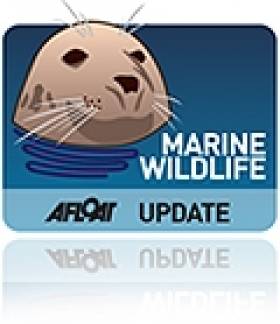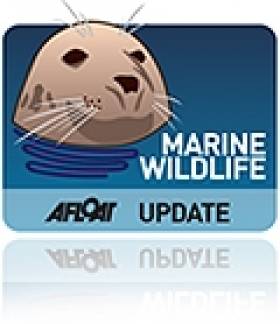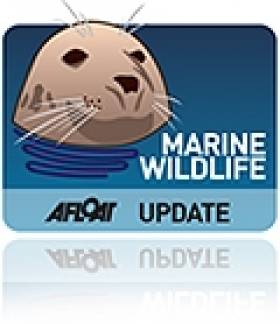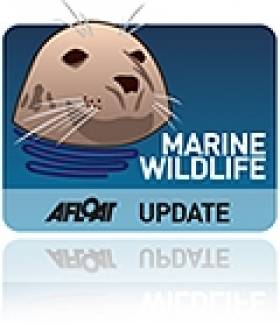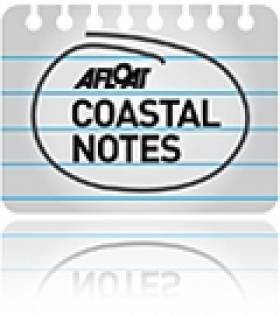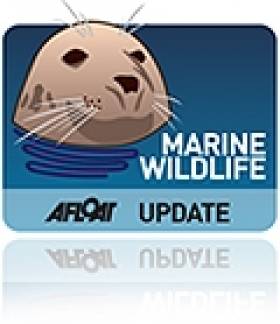Displaying items by tag: Cetaceans
Ireland's Coasts Are Waiting For Summer Whale Spotters
#MarineWildlife - Though the winter months comprise Ireland's major whale-watching season, this time of year brings more people to the coasts to witness Ireland's bounty of marine wildlife.
And if you're not sure where to look, BreakingNews.ie has a guide to some of the best opportunities for cetacean spotting.
Whether boating off Baltimore, kayaking off Kerry or simply hogging the binoculars from cliffs and headlands around our coasts, there's a good chance of sighting some of the many species of whales, dolphins and porpoise that call Irish waters home - or at least come to visit for a few months.
And that's not to mention our good friends the basking sharks, the ocean's second-largest fish, and the seal colonies that regularly entertain harbour-goers.
The guide also reminds potential spotters what to look out for, such as sudden reflections on the water, unusual vapour in the air, ripples against the current or seabirds going wild over a certain feeding spot.
If you're lucky, you may even have an encounter like the Ballyholme Yacht Club members who saw a humpback whale near the Copeland Islands in the North Channel recently, one of only a handful of sightings off the Co Down coast in the last 100 years.
Talks On Whale & Dolphin Monitoring In Belmullet This Thursday
#MarineWildlife - The Irish Whale and Dolphin Group (IWDG) will be co-hosting an evening of talks on cetacean research at the Belmullet Civic Centre this coming Thursday 27 March.
Held in conjunction with the Coastal & Marine Research Centre at University College Cork, the evening will see a talk by Barry McGovern on the CMRC's work in Broadhaven Bay as part of the Corrib Gas Project in Co Mayo over the past decade.
In addition, the IWDG's Dr Simon Berrow will look at whale and dolphin strandings around Ireland, with a focus on Belmullet.
The IWDG has more details on the evening HERE.
Whale and Dolphin Strandings Reach 'Record High' Says IWDG
#MarineWildlife - The Irish Whale and Dolphin Group (IWDG) has expressed its dismay at the continued rise in whale, dolphin and porpoise strandings around Ireland in 2013.
"The question was whether the numbers for 2012 were just a temporary ‘blip’ in the trend and would the figures for Ireland return to a more ‘normal’ 145 or so for 2013," writes IWDG strandings officer Mick O'Connell on the group's website.
"Well, as we head towards the start of winter, we can see that the answer is a most definite ‘no’."
O'Connell explains that by the end of the first week of October this year, the group had received validated reports for 175 cetacean stranding incidents - matching the total for the 12 months of 2012.
"With a good few weeks left until the years end, it’s likely that for the first time ever, the strandings database will receive 200-plus cetacean stranding records," he writes, adding that there is as yet "no explanation as to the cause or causes for the significant increase in figures" - though it's so far clear that the biggest increase is among common dolphins.
#MarineWildlife - The Irish Whale and Dolphin Group (IWDG) has welcomed recent measures to protect deep-diving cetaceans from the potential effects of seismic survey noise.
The new measures have been implemented by the Petroleum Affairs Division (PAD) of the Department of Communications, Energy and Natural Resources and the National Parks and Wildlife Service (NPWS).
As a result, the environmental management plan for the 2D seismic survey of the Irish EEZ, being conducted by ENI Ireland BV in conjunction with the PAD, includes the establishment of a 'mitigation zone' along key parts of the continental shelf margin from which all seismic survey is excluded.
The management plan was informed by two projects recently conducted by the IWDG: the recently published Atlas of the Offshore Distribution of Marine Mammals in Irish Waters (funded by the the NPWS and the Marine Institute); and the Beaked Whale Passive Acsoutic Monitoring Pilot, conducted in the Rockall Trough and funded by the PAD.
Both these projects identified areas of the Irish shelf slopes as being of importance to deep-diving cetaceans such as beaked whales, sperm whales and pilot whales.
The mitigation zones implemented during the ENI/PAD 2D survey show how collected data can directly contribute to cetacean conservation in Irish waters, according to the IWDG.
In other news, the IWDG has been carrying out its own survey in North Kerry to investigate the use of Tralee Bay and Bandon Bay by bottlenose dolphins, and assess the potential for marine wildlife tourism in the region.
Since May, Drs Simon Berrow and Joanne O'Brien have ben working with the local community in Fenit and North Kerry to survey and record dolphins and other cetaceans to build up a better understanding of how they use the bays.
The IWDG has also deployed three C-PODs across the bays to acoustically monitor the area for dolphins.
"It has long been known that Tralee and Brandon Bays are the only site where the resident bottlenose dolphins in the Shannon Estuary occur," said Dr Berrow. "The bottlenose dolphins in the Shannon are a genetically discrete population with a relatively small population of around 120-140 individuals. The Shannon is protected for bottlenose dolphins but Tralee and Brandon Bays are not.
"Since the start of this project, which is funded by North and East Kerry Development, we have encountered bottlenose dolphins on every trip. Photo IDs have established them to be Shannon dolphins, and they have been detected acoustically on nearly 90% of days at some sites."
Celtic Mist, the IWDG's research vessel, has been joined by local boats in surveying the area and on Wednesday last (6 August) it encountered a large group of bottlenose dolphins in Brandon Bay - captured on video by local filmmaker James McCarthy:
#MarineWildlife - A humpback whale new to Irish waters has been confirmed by the Irish Whale and Dolphin Group (IWDG).
Photos of the humpback's fluke and dorsal fin captured by Nick Massett off Clogher and Sybil Heads in West Kerry at the weekend were examined by the IWDG's catalogue experts who have determined that the whale is a new arrival - and one with a fluke colouring that's rarely seen in Irish waters.
Details have since been sent to Allied Whale in the US state of Maine - which curates the North Atlantic humpback whale catalogue - to see if a match can be made among its database of more than 7,000 fluke images.
Meanwhile, Wildlife Extra reports that sailors in the Irish Sea are urged to keep a lookout for a large group of minke whales.
The group includes three juveniles and a calf previously spotted some 19 miles east of Ireland's Eye near Howth.
"Although sightings of Minke whale are to be expected in these waters, such a large group is a rare occurrence," said Danielle Gibas, sightings officer with the UK's Sea Watch Foundation, which is organising Britain's annual National Whale and Dolphin Watch this week till 3 August.
And in other cetacean news, scientists claim that dolphins call each other by name, calling back to the sound of their signature whistle but ignoring whistles that aren't theirs.
Herald.ie reports on the findings by marine scientists at the University of St Andrews, who studied a bottlenose dolphin group off the east coast of Scotland.
Using underwater speakers, they played synthesised versions of dolphin whistles they'd identified with particular dolphins to determine their reactions.
They were surprised to find that individuals called back after hearing their own 'name' but ignored others, whether they were for dolphins in the same group or strangers.
New Atlas Of Ireland's Offshore Marine Mammals Launched
#MarineWildlife - Minister for Arts, Heritage and the Gaeltacht Jimmy Deenihan was on board the Irish Whale and Dolphin Group's (IWDG) research vessel Celtic Mist yesterday 16 July to launch a new atlas of marine mammals in Ireland's coastal waters.
The Atlas of the Distribution and Relative Abundance of Marine Mammals in Irish Offshore Waters marks the culmination of six years of surveys involving more than 1,000 says at sea, and provides up to date information for 19 species of cetaceans: whales, dolphins and porpoises.
Ireland is home to a remarkable diversity of whales and dolphins, and the new atlas shows how common and widespread some of these species are - from the harbour porpoise and common dolphin to the much larger fin whale.
Not all Irish cetaceans are so common, however, and the atlas also highlights the importance of Irish waters for some of the Atlantic’s rarer deepwater species such as the sperm whale and several beaked whales.
These are species about which very little is known, the IWDG says more work will be required in the coming years to allow a better understanding of the conservation requirements of these animals.
Every six years, Ireland is obliged to report on the conservation status of all of its marine mammals as part of its commitments under the European Union’s Habitats Directive. The data from this atlas has already proved invaluable in underpinning Ireland’s 2013 report to the European Commission.
Speaking at the launch yesterday in Dun Laoghaire, Minister Deenihan commended the work undertaken to produce the atlas.
“This fine atlas is the culmination of many years of work by a large number of people and I’m happy to note that it was produced under a project funded over several years by my department in collaboration with the Marine Institute," he said.
"As minister, I have also extended the protection afforded to whales and dolphins through the designation of additional marine special areas of conservation. I would like to thank the Irish Whale and Dolphin Group for this excellent publication.”
The atlas is available as a PDF to download HERE.
New Research Says Sonar Sends Whales Scurrying
#MarineWildlife - The Guardian reports on new research which proves that military sonar has a direct effect on the behaviour of whales in our oceans - even leading to mass strandings.
The studies, part funded by the US Navy, found that beaked whales where particularly sensitive to sonar - and that even blue whales, the largest animals on earth, were distracted from feeding by the subsurface noise.
It's long been feared that the use of sonar is to blame for unusual behaviour among whales, who navigate and communicate with each other over long distances using sound.
As previously reported on Afloat.ie, the Irish Whale and Dolphin Group (IWDG) identified sonar activity by Royal Navy submarines as a possible cause of a the mass stranding of pilot whales in Donegal in November 2010, in which as many as 35 whales died.
Now for the first time, sonar has been proven to affect behaviour of cetaceans to a detrimental degree, confirming for many a connection between the use of sonar technology and recordings of whale and dolphin strandings identified since the 1950s. The Guardian has much more on the story HERE.
In more positive whale-related news, the IWDG reports that its next Cape Clear summer whalewatching course over the weekend of 26-28 July is "filling up nicely".
Places are still available but as it coincides with the tourism high season in West Cork, anyone interested is advised to book sooner than later to ensure they have someone to stay nearby.
The most recent weekend course over the June bank holiday witnessed numerous harbour porpoises and common dolphins, but its hoped the elusive whales will make an appearance next time round!
Whale & Dolphin Group To Retrace Journalist's Whaling Voyage
#MarineWildlife - An upcoming research cruise by the Irish Whale and Dolphin Group (IWDG) is set to follow the path of a famous whaling voyage embarked on by an Irish Times journalist more than 100 years ago.
The paper reports on the pending mission by the marine wildlife charity's Celtic Mist research vessel that will retrace the movements of Crawford Hartnell from the site of what was then a Norwegian whaling station in the Inishkea Islands off the Mullet Peninsula in Mayo to a point 160km west where Hartnell report the harpooning of two whales.
Hartnell's accounts of his whaling adventure are remembered today for their blood-soaked vividness - but the IWDG's advances are altogether more friendly.
Rather than harpoon their quarry, the researchers on board the Celtic Mist will be on the lookout for baleen and beaked whales to count - and will also be teaching IWDG members how to identify species, how to carry out sea-bound surveys and how to use hydrophones to identify cetaceans by the sounds they make beneath the waves.
The Irish Times has much more on the story HERE.
Windy City Premiere For Short Film Shot in West Cork
#CoastalNotes - A new Irish short film shot on location on the south-west coast will have its premiere in Chicago this weekend, as the Southern Star reports.
The Blow-Ins is a 15-minute adventure comedy that was shot in Courtmacsherry, Kilbrittain and other picturesque coastal spots in West Cork.
It fictionalises story of the notorious Kilbrittain whale that washed ashore in 2009, as a family of 'blow-ins' from the capital attempt to rescue the stranded cetacean.
Written and directed by CJ Scuffins for Story Factory, The Blow-Ins will premiere at the 14th Chicago Irish Film Festival from Friday 1 March after its recent acclaim at the recent Corona Cork Film Festival.
The Southern Star has more on the story HERE.
Recent Dolphin, Whale Strandings 'Very Unusual' Says IWDG
#MarineWildlife - The Irish Whale and Dolphin Group (IWDG) has described as "very unusual" a mass stranding of common dolphins on Achill Island last week - which was followed this week by the remains of cetaceans washed up in Kerry.
At least eight common dolphins were found dead on Keel Beach, Keem Beach and Dookinella on the Co Mayo island at the end of January.
And The Irish Times reports that two pilot whales and an "otherwise healthy" dolphin were found washed up at Cuas Croom near Cahirciveen in the last few days.
Commenting on the former incident, IWDG stranding officer Mick O'Connell said: "While there are occasionally live strandings involving groups of dolphins, it is very unusual in this country to see this number of dead dolphins washed ashore over a 10km area."
Strandings of deceased dolphins have also been reported in Donegal, and the IWDG's Simon Berrow suggests that the recent severe weather experienced around Ireland's coast may be a factor.


























